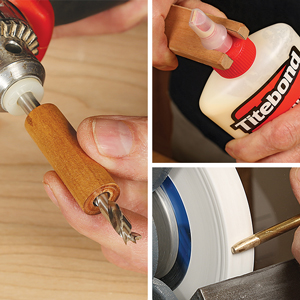Become a Shooting Board Master
Master the shooting board and take your woodworking skills to the next level.Fine Woodworking has covered a wide variety of shooting boards over the years, and while all of them work beautifully, wouldn’t it be wonderful to distill all those great designs into one perfect board?
Furniture maker and teacher Timothy Rousseau has done just that. By combining the best elements of a variety of shooting board designs, he’s come up with a benchtop gem that’s perfect for squaring up furniture parts quickly and easily.
Shooting Board Basics
In its simplest form, a shooting board is nothing more than a base with a fence that registers against your workbench’s front apron, or inside your face vise. An additional fence on the top side of the base allows you to hold workpieces perfectly square against it. This lets you to pass a handplane (on it’s side) along the entire edge of the board. These little shopmade bench jigs are perfect for truing up end grain, as well as a whole host of other operations.
In this short video, Rousseau takes you through the shooting board style he uses most, with tips on how to use it to its maximum potential.





















Comments
The video is not available
I haven’t used a shooting board yet, but one thing that is not clear to me is how does the plane blade NOT shave the edge of the plywood base when using? Eventually ruining the trueness of the board?
That is probably one of most asked questions on shooting boards. Thankfully, Matt Kenney wrote a great blog that explains it here: https://www.finewoodworking.com/2010/09/17/heres-why-your-plane-doesnt-keep-cutting-into-your-shooting-board
Thanks for this video. Been playing around with trying to simplify the shooting boards I use (some of my problems are admittedly user error... as simple as these tools are, they definitely take some practice to understand.)
Looking forward to giving this one a shot.
It’s easy, but only if the side of your plane is 90 degrees to the sole, and you have a high quality blade that is razor sharp, and the cap iron is set right, and the blade is protruding by the right amount,and the lateral adjustment is set correctly, and there is plenty of side area so it doesn’t rock, and you have a comfortable grip.
As a woodworker whose only machine is a bandsaw, I use shootingboards. I may give this one a try. I certainly prefer this simpler clamp-down version to the unnecessarily complicated T-nut-and-screw version that just appeared in FWW#267.
Nice and to the point. I like the simple design and how easy it is squared up.
Tim, yet another article you hit a home run with, excellent! I will definitely be making one of these, simple yet very functional. Thanks again Tim
Thanks, Tim, This is perfect for my small shop where I need to economize on space. My jigs seem to be taking over. Do you or does anyone have a similarly economical suggestion for mitering 45 degree box corners that are 2 to 8 inches long?
Todd Crenshaw’s shooting board for case miters (included in this project guide) should accomplish this particularly well.
From experience, you can't get things square by using an adjustable combination square as a reference for 90 degrees or 45 degrees. The adjustability of the beam results in about 1 degree, maybe a bit less, of play and inaccuracy. Get one or more Starrett fixed blade squares. I also have an Incra fixed blade square and 45 degree reference. These have guaranteed tolerances and will remain accurate unless you drop 'em.
These fine tools are also very useful when setting up your table saw, jointer etc.
Log in or create an account to post a comment.
Sign up Log in